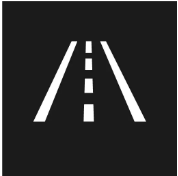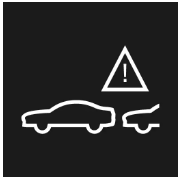2022 Polestar 2 Driver support General topics

Braking assist after a collision
After a serious collision, it may no longer be possible to control and steer the vehicle. In order to avoid or mitigate a possible further collision with a vehicle or an object in the vehicle’s path, the brake assist system is activated automatically to help stop the vehicle safely.
The brake lights and hazard warning flashers are activated during braking. When the vehicle has stopped, the hazard warning flashers will continue to flash and the parking brake will be applied.
If braking is not appropriate, e.g. if there is a risk of being hit by passing traffic, the driver can override the system by depressing the accelerator pedal.
This function assumes that the brake system is intact after a collision.
Driver support systems
The systems can, for example, help the driver:
- maintain a set speed
- maintain a set time interval to the vehicle ahead
- help prevent a collision by warning the driver and applying the brakes
- park the vehicle.
Some of the systems are standard and others are options. This also varies from market to market.
Some of the systems have improved functionality when Google Maps is being used.
The functions are supplementary aids – they cannot manage all situations in all conditions. The driver is always responsible for ensuring that the vehicle is driven in a safe manner and in accordance with applicable traffic rules and regulations.
Driver support warnings
Read the individual parts about each system to fully understand the functions and be notified of important warnings.

Assistance during collision risks can help the driver avoid a collision by providing warnings, automatic braking and steering assistance.
The function contains sub-functions that can provide assistance in various situations. How the function is experienced can therefore differ depending on which sub-function is activated.
Assistance during collision risks can, if necessary, provide the following:
- Collision warning
- Brake assistance
- Automatic braking
- Steering assistance

Lane Keeping Aid can help you reduce the risk of the vehicle inadvertently veering out of its own lane. Because you can set preferences for how the function provides assistance, individual experiences of this safety function may vary.
- Assist: If the function detects that the vehicle is approaching a lane marker line, you will feel light pressure applied to the steering wheel. Both hands must be on the steering wheel for this function to work.
- WARNING: If the function detects that the vehicle is approaching a lane marker line, you will be alerted through vibrations in the steering wheel.
- Both: You are alerted to vibrations and light pressure on the steering wheel.

Rear Collision Warning is a system that can help you avoid being hit from behind by an approaching vehicle. If the system detects a collision risk from behind, it can alert you and provide the following types of assistance depending on the situation.
- Rapid flashing of direction indicators.
- At lower speeds, the function can tension the seat belts by activating the seat belt tensioners and the Whiplash Protection System.
- If the vehicle is stationary, the brakes can be applied.

BLIS is designed to help provide assistance in heavy traffic with several lanes moving in the same direction by alerting the driver to rapidly approaching vehicles and to the presence of vehicles in the “blind spot” area behind and to the side of your vehicle.

- Warning with an indicator light in the door mirror, with steady and flashing lights.

The function is designed to help alert the driver to erratic behavior, for example if the driver is distracted or showing signs of fatigue.
- Audible signal combined with a symbol in the instrument panel and a message.

There are two functions that can help the driver avoid a collision while backing up.
- Cross Traffic Alert (CTA)* is designed to alert the driver of crossing traffic when the vehicle is backing up.
- Rear Auto Brake (RAB)* is designed to help the driver detect stationary obstacles directly behind the vehicle when backing up.
If an obstacle is detected:
- A warning signal and the Park Assist graphic illuminate to indicate the location of the obstacle.
- If the driver does not react to the warning and a collision is unavoidable, the vehicle will automatically brake, and a message will appear explaining why the brakes were applied.
The functions described here are supplementary aids – they cannot manage all situations in all conditions.
The driver is always responsible for ensuring that the vehicle is driven in a safe manner and in accordance with applicable traffic rules and regulations.
Ready to drive notification
To help prevent the vehicle from remaining stationary too long and causing traffic disturbances, the Ready to Drive Notification function can provide an audible signal and display a symbol and message in the instrument panel. If the system detects pedestrians or cyclists near the vehicle, notification might not be provided.
However, the system cannot detect pedestrians and cyclists in all situations. The driver is always responsible for ensuring that the vehicle is operated in a safe manner.
To activate or deactivate the function:
- Tap
 in the center display.
in the center display.
- Tap Assist and change to the desired setting.
- The function is supplementary driver support intended to facilitate driving and help make it safer – it cannot handle all situations in all traffic, weather and road conditions.
- The driver is advised to read all sections in the Manual about this function to learn of its limitations, which the driver must be aware of before using the function.
- Driver support functions are not a substitute for the driver’s attention and judgment. The driver is always responsible for ensuring the vehicle is driven in a safe manner, at the appropriate speed, with an appropriate distance to other vehicles, and in accordance with current traffic rules and regulations.
The function uses the vehicle’s camera and/or radar units, which have certain general limitations.
Speed-dependent steering wheel resistance

On reduced power, the message Power steering assistance Temporarily reduced is shown, and this symbol appears in the instrument panel.
While the power steering is working at reduced power, the driver support functions and systems with steering assistance are not available.
If the temperature rises too high, the power steering may be forced to switch off completely. In such a situation, the driver display shows the message Stop safely Power steering failure along with a symbol.
- Tap
 in the center display.
in the center display.
- Tap Drive.
- Select a steering setting.
Steering wheel resistance settings can only be accessed if the vehicle is stationary or is moving straight ahead at a low speed.

